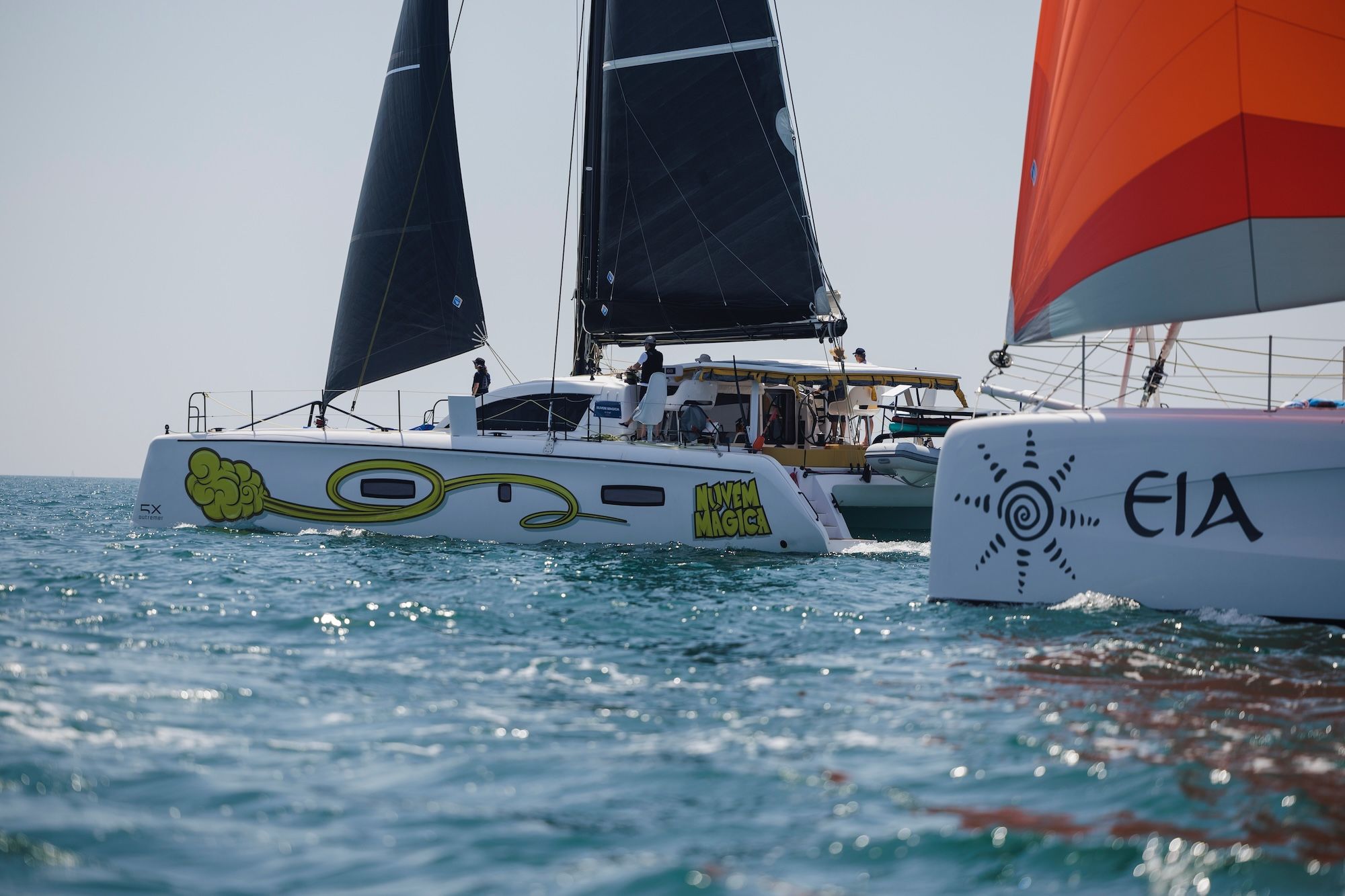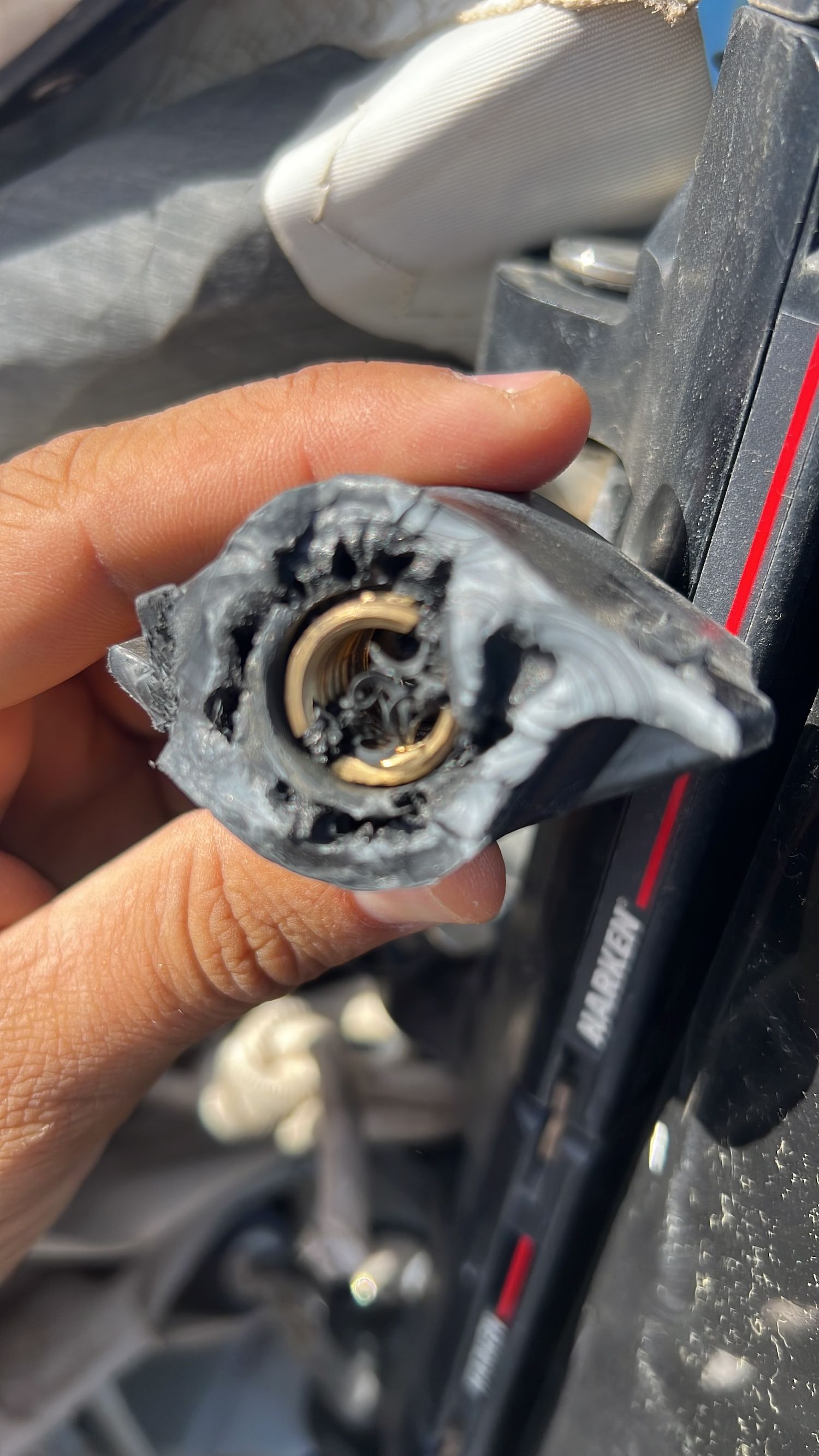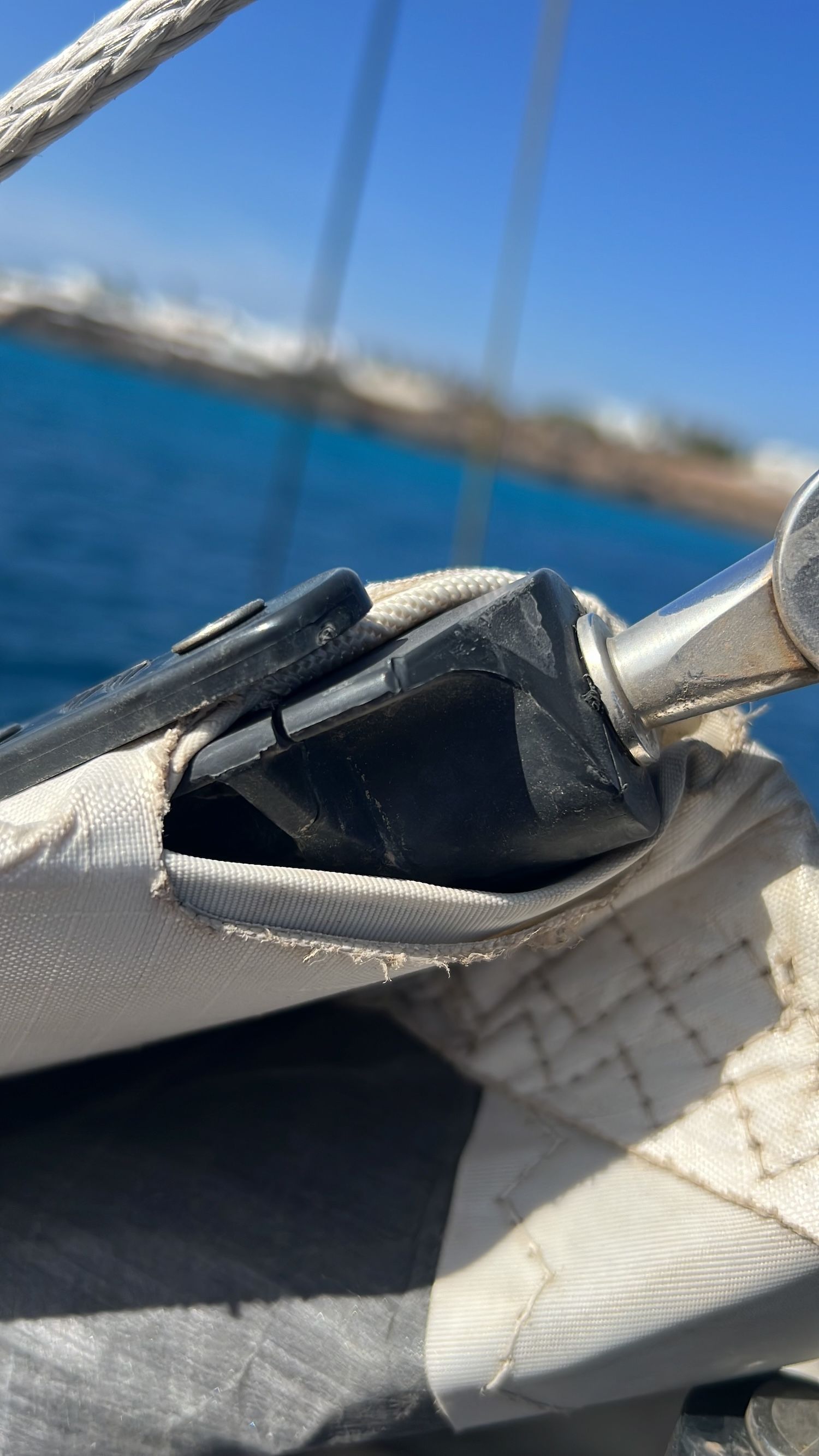Material fatigue is real, and the ocean is an absolutely unforgiving environment. From constant movement and friction, to incredible forces and oxidation, your boat is always being put to the test, by you and by the environment. Therefore, even if you do feel confident or have just successfully completed a passage, you should always and regularly check e-ve-ry-thing.
In this post we share our preparation steps when it comes to: 🔩 rigging, ⛵️ sails, as well as ⛽️ engine checks and fixes.
🔩 Rigging#
First things first…#
Let’s talk about the ideal case. Ideally, you know exactly:
- 🔖 What you have;
- ⚙️ What it does;
- 💪 Whether it works.
Rigging, however, is no easy topic. On top of it, as Andy Schell puts it: “Standing rigging is only as strong as the weakest pin”. Thus, it is well worth investing the time to document and understand what you have.
To figure out what you have, it helps to break a rigging setup into categories:
- Spars: mast, boom, pole(s);
- Running rigging: i.e., that which is used for raising, lowering, shaping and controlling the sails (e.g., sheets and halyards);
- Standing rigging: i.e., that which supports the mast and bowsprit (e.g., shrouds, spreaders and chainplates).
To document what you have, you can:
- Gather the boat documentation you have at hand;
- Measure things yourself (going aloft or on deck);
- Ask a friend who knows more about rigging than you do;
- Do all of the above.
You’ll want to spec everything, ideally even construct a diagram and check that everything is well dimensioned. In any case, inspect your rigging often: before the departure, when underway and upon arrival.

Pre-departure#
Inspection Methodology#
Whatever order you choose, have a system and make sure to inspect everything from (1) bow to stern and (2) top to bottom.
In doing so:
- 🧗 Climb every inch of the rig;
- 🔁 Climb the back and the front of the mast;
- 🙈 Check the underside, covered or hidden parts as best you can;
- ↕️ Pay attention when coming down as much as when going up;
- 🤙 Don’t just look, feel it too. Pass your fingers and your nail;
- 📸 Take pictures.
You’ll hear and read many cautionary tales, but know that many potential disasters can be averted thanks to preventive and proactive action.
Examples: halyard chafe#
One issue that dragged for quite some time concerned our running rigging. To make a long story short: We detected that our halyards were not passed correctly inside the mast, leading to recurrent and serious chafe.
We got the halyard replaced with an extra long oversheating. However, the underlying problem was not solved and, therefore, the chafe came back, quickly. We got thinking and came up with the hypothesis that the halyard might have been passed incorrectly inside the mast. We bought 2 endoscopic cameras to diagnose this and, once in Las Palmas, we got to work. This became an important issue to solve, not only because of the halyard itself, but also because metal can also fall victim to chafe, and we knew from climbing that ropes and lines can chafe metal over time.

Grand Large Services, the after-after-sales company that is part of Grand Large Yatching (owner of the Outremer Shipyard), sent the amazing Sylvain Quinton to help us and, for a whole day, using an endoscopic camera, a magnet and a messenger line, we performed laparoscopic mast surgery and managed to pass the halyards correctly! Yes, without taking the mast down! 🥂
Seize them shackles!#
Another recurring issue we experienced was failure of the shackle at the tack of the main sail. Originally, the boat came with zip ties from the factory. However, we realized that (1) the zip tie would break very quickly and (2) we would not know where it went (and the ocean does not need more plastic!). During the ARC+ seminars in Las Palmas, we received the recommendation to seize shackles with stainless steel wire. We did it and are very happy with the results 👇
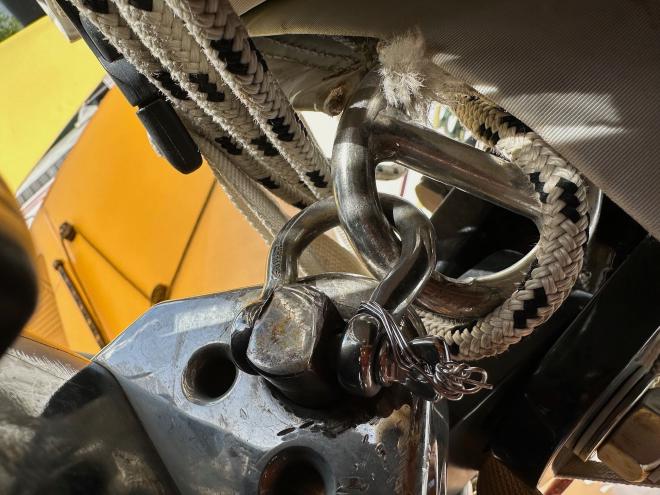
During the crossing#
During an offshore passage, you’ll want to inspect your rigging at least once daily. In case of an unexpected load on the rig, consider checking more often. For instance, should you crash gybe, check your gooseneck immediately afterwards.
On Nuvem Mágica, Inês performed the daily checks and always had a second person with her. We used our eyes, our hands, and binoculars. And we were constantly checking for chafe.
These daily checks not only implied a nice stroll on the boat every morning, but also helped us avoid a potentially serious situation. Indeed, we found that the pin holding the gooseneck setup was being crushed, and promptly checked the gooseneck and replaced the pin.

Upon arrival#
Upon arrival, we had our rhum (maybe >1), but quickly went up the mast again to do a full rig check once more. Use your checklists and compare your before pictures with the current ones. Rinse everything with fresh water, and make a list of the spares you used (for which you need to buy replacements).
⛵️ Sails#
Our sail plan#
It is important to know that an Atlantic crossing means, in principle, a majority of downwind sailing (although those crossing the ocean have seen a wide variety of wind angles in recent years). As such, you need to be prepared with an adequate downwind sail plan. When we got the boat, Nuvem Mágica came with a gennaker, a code zero, a self-tacking jib and a mainsail. Thus, our main downwind sail was the gennacker. However, this sail only allowed us to sail up to 150 True Wind Angle (TWA).
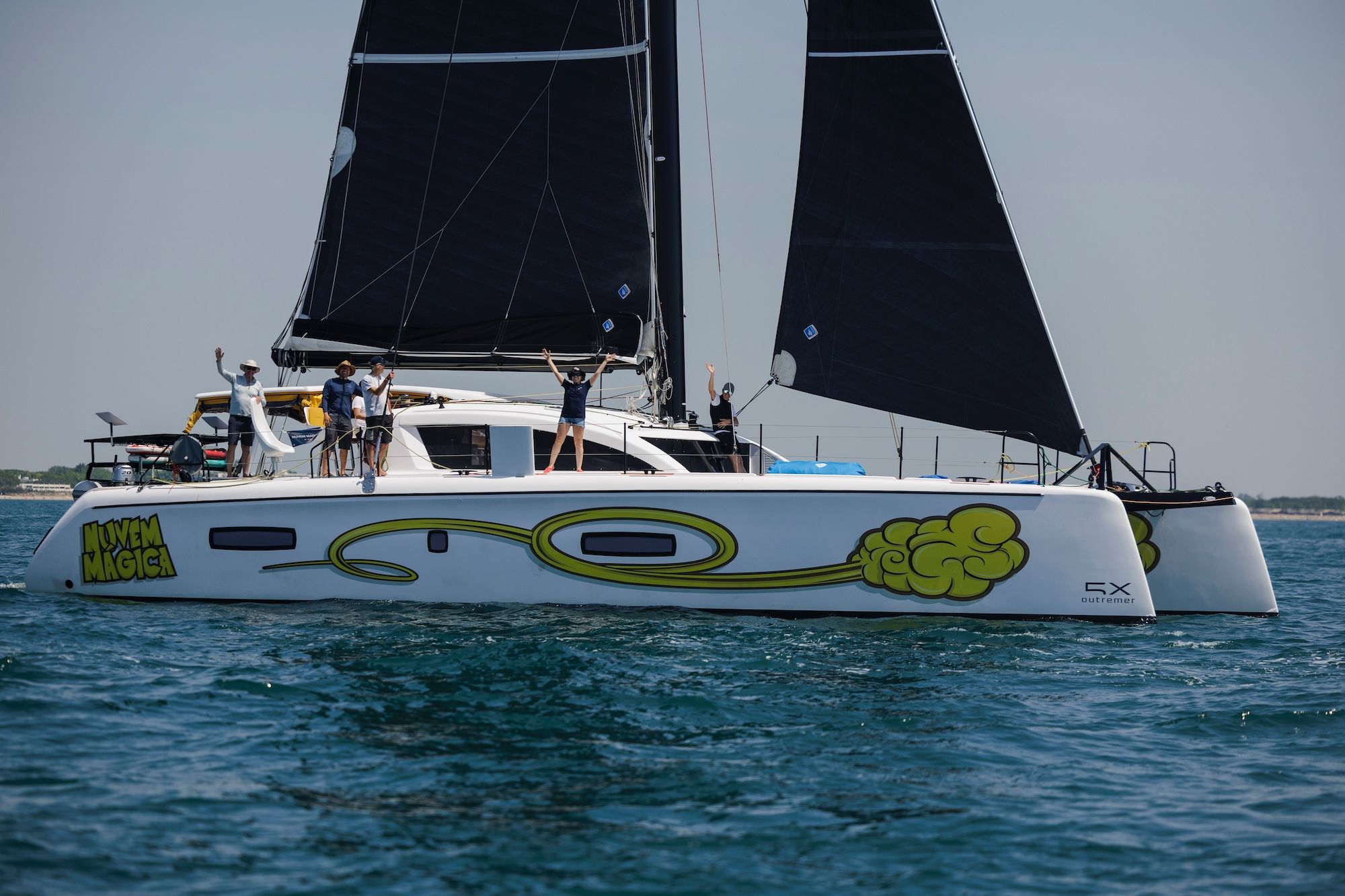
To be able to go deeper, we purchased an asymmetric (A2) and a symmetric spinnaker. Unfortunately, the A2 did not arrive on time and we were only able to receive it in Grenada, after the crossing. We had to do with the symetric spinnacker only… or did we? Can’t wait to share the episode of Leg 1… 😅
Other downwind sail plans#
Being part of the ARC+ allowed us to compare our downwind sail plan with that of others. We saw Parasailors, North Sails tradewind sails (sometimes called downwind runners), wing on wing setups… and more! For a review of the multiple options available, have a look at this online seminar from the World Cruising Club.
Batten fittings that pop like popcorn#
Besides getting the right sails for the job, we also had our share of fixes before the trip 🍿.
One notable one concerned our batten fittings, a piece of equipment that connects the battens of the main sail to the Harken carts on our main sail track. Our original batten fittings were made of a soft plastic and kept breaking (Nautix). As it turns out, they were underspecced for the type of sail we have (Incidence DFi) and the size of the main sail on Nuvem Mágica.
After several discussions with Outremer and Incidence Sails, they were kind enough to ship more resistant ones made of aluminium from Antal. We didn’t manage to get these installed before the crossing (they were in the same package as our A2 that never arrived), so we replaced the broken ones with spares and carried a few extra spares just in case.

⛽️ Engine#
Engines are another important and complex piece of equipment. To understand their function, it helps to know their goal: creating the circular motion of the propeller, which, as the name indicates, propels you forward.
We won’t be able to explain the inner workings of engines in a blog post section but we can (1) recommend resources for you to know more, (2) provide our checklists for engine checks and (3) discuss how to think about your diesel plan for an offshore passage.
For the former, here are some resources we use and love:
- How a car works: excellent video course, currently with an early bird offer and still being built! We do not know any of the people building the course, but we wish we did!
- RYA Diesel Engine Handbook: which includes information about how an engine is structured, setup tips, maintenance and troubleshooting workflows.
Regarding checks, here is an acronym we learned in our very first sailing course: I WOBBLE U 🫨.
I WOBBLE U#
I WOBBLE U stands for:
- Isolation: make sure the engine battery is turned off, so no one turns on the engine while you’re checking it.
- Water: check the coolant level
- Oil: check the oil level
- Belts: check the belt tension
- Bildges: any water or fluids in the engine room floor?
- Leaks: check for leaks
- Electricity: visual inspection of all the electrical components
- Undo isolation: you can turn on the engine battery again if you so wish
We do WOBBLEs (as we put it) every time we go sailing, so fairly regularly.
On top of these checks, you’ll want to have your engine manufacturer’s manual at hand (e.g., Volvo), to know exactly when and where you should conduct your engine revisions. Here is the list we have created and use to keep on top of things.
Be present during the revision process, ask questions and take pictures. It will help you know the intricacies of your engine, learn how things are done and check all the work in one go.
If you have an engine revision due before the crossing, be sure to schedule it with enough time. We did this, but that still did not save us from some last minute problems. More on that in a later post 😉.
Fuel plan#
Finally, you’ll need to think about how much diesel you’ll want to pack for an ocean crossing. Some sailors will have strong opinions about specific numbers, but what you’ll want to know is what you’re planning for. For us, our worst case scenario was to be unable to sail in the middle of the ocean. Therefore, we packed enough diesel to motor ~1200 nautical miles in an emergency. We filled up some jerrycans with extra diesel in Gibraltar, where fuel prices are lower.
One tip: if you decide to fill up jerrycans, leave some air inside, so they can float.
🔚 In short…#
We hope these teasers into the different topics will encourage you to take deeper dives 🤿. Feel free to also have a look at the resources we leave below for some more in-depth reading 📖.
Last but not least, don’t forget that these systems always require ongoing maintenance and frequent inspections. We thought we were ready when we got to Las Palmas, but little did we know 😅… Stay tuned for our pre-departure and Leg 1 accounts in future posts!
Until then,
Fair winds and stable rigs 🤜
📚 Resources#
- Nuvem Mágica Engine revision list
- ARC Bluewater Preparations - Downwind sails plans
- Chafe, the Quarterdeck podcast
- Rig Climbing for Sailors, the Quarterdeck podcast
- Rig Inspections, the Quarterdeck podcast
- Debate: Symmetric vs. Asymmetric Spinnakers, the Quarterdeck podcast
- RYA Diesel Engine Handbook
- The Complete Rigger’s Apprentice
- Inspecting your rig with Brion Toss





